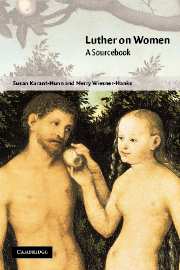10 - Witchcraft and magic
Published online by Cambridge University Press: 05 June 2012
Summary
During the sixteenth and seventeenth centuries between 100,000 and 200,000 people were officially tried, and between 50,000 and 100,000 executed for witchcraft in Europe. Of these, about 80–85 percent were women, though this percentage varied throughout Europe. Both Protestant and Catholic authorities tried and executed witches, with the Holy Roman Empire, Switzerland, and eastern France seeing the highest levels of persecution. The early modern upsurge in witch trials – often called the “Witch Craze” or the “Great Witch Hunt” – is an extremely complex phenomenon which has been the subject of a huge number of studies over the last thirty years; most of these emphasize the ways in which economic, social, political, legal, theological, and intellectual factors all played a role.
Luther did not write a systematic treatise on witchcraft, so his ideas emerge in discussions of Biblical references to witchcraft and in the table talk. These ideas did not break dramatically with those of late medieval Christian thinkers. Most historians of witchcraft note that during the late Middle Ages, Christian philosophers and theologians developed a new idea about the most important characteristics of a witch. Until that period in Europe, as in most cultures throughout the world, a witch was a person who used magical forces to do evil deeds (maleficia). One was a witch, therefore, because of what one did, causing injuries or harm to animals and people. This notion of witchcraft continued in Europe, but to it was added a demonological component.
- Type
- Chapter
- Information
- Luther on WomenA Sourcebook, pp. 228 - 237Publisher: Cambridge University PressPrint publication year: 2003

